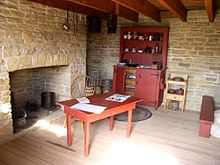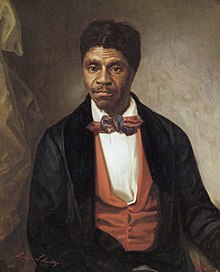Dred Scott
In a landmark case, the United States Supreme Court decided 7–2 against Scott, finding that neither he nor any other person of African ancestry could claim citizenship in the United States, and therefore Scott could not bring suit in federal court under diversity of citizenship rules.
Scott's temporary residence in free territory outside Missouri did not bring about his emancipation, because the Missouri Compromise, which made that territory free by prohibiting slavery north of the 36°30′ parallel, was unconstitutional because it "deprives citizens of their [slave] property without due process of law".
Although Chief Justice Roger B. Taney had hoped to settle issues related to slavery and congressional authority by this decision, it aroused public outrage, deepened sectional tensions between the northern and southern states, and hastened the eventual explosion of their differences into the American Civil War.
President Abraham Lincoln's Emancipation Proclamation in 1863 and the post-Civil War Reconstruction Amendments—the Thirteenth, Fourteenth and Fifteenth amendments—nullified the decision.
[5] Dred Scott was sold to Dr. John Emerson, a surgeon serving in the United States Army, who planned to move to Rock Island, Illinois.
[5] In February 1838, Emerson met and married Eliza Irene Sanford in Louisiana, whereupon he sent for the Scotts to join him, only to be reassigned to Fort Snelling later that year.
That is, because the Scotts had been held voluntarily for an extended period by their owner in a free territory, which provided for slaves to be freed under such conditions, the court ruled, they had gained their freedom.
She was a frequent churchgoer, and in St. Louis, her church pastor (a well-known abolitionist) connected the Scotts to their first lawyer.
Justice Hamilton R. Gamble, who was later appointed as governor of Missouri, sharply disagreed with the majority decision and wrote a dissenting opinion.
[16] Rather than settling issues, as Taney had hoped, the court's ruling in the Scott case increased tensions between pro-slavery and anti-slavery factions in both North and South, further pushing the country toward the brink of civil war.
While the case was pending, the St. Louis County sheriff held these payments in escrow and leased Scott out for fees.
[5] Scott worked as a janitor at LaBeaume's law office, which was shared with lawyer Roswell Field.
His brother Benjamin was an Associate Supreme Court Justice and wrote one of the two dissents in Dred Scott v.
He was elected to the U.S. Congress in 1854 and fiercely attacked by pro-slavery newspapers for his apparent hypocrisy in owning slaves.
[20] About a century later, a historian established that John Sanford never legally owned Dred Scott, nor did he serve as executor of Dr. Emerson's will.
[19] It was unnecessary to find a New Yorker to secure diversity jurisdiction of the federal courts, as Irene Emerson Chaffee (still legally the owner) had become a resident of Massachusetts.
[20] However, Sanford had been involved in the case since the beginning, as he had secured a lawyer to defend Mrs. Emerson in the original state lawsuit before she married Chaffee.
[10] Following the ruling, the Chaffees deeded the Scott family to Republican Congressman Taylor Blow, who manumitted them on May 26, 1857.
Scott worked as a porter in a St. Louis hotel, but his freedom was short-lived; he died from tuberculosis in September 1858.
[24] A local tradition later developed of placing Lincoln pennies on top of Scott's gravestone for good luck.
One of Eliza's sons died young, but the other married and has descendants, some of whom still live in St. Louis as of 2023,[25] including Lynne M. Jackson, Scott's great-great-granddaughter, who led the successful effort to install a new towering memorial at Dred Scott's grave at Calvary Cemetery on September 30, 2023.
[18] The newspaper coverage of the court ruling, and the 10-year legal battle raised awareness of slavery in non-slave states.
The words of the decision built popular opinion and voter sentiment for his Emancipation Proclamation and the three constitutional amendments ratified shortly after the Civil War: The Thirteenth, Fourteenth and Fifteenth amendments, abolishing slavery, granting former slaves' citizenship, and conferring citizenship to anyone born in the United States and "subject to the jurisdiction thereof" (excluding subjects to a foreign power such as children of foreign ambassadors).
[27] Gregory J. Wallance published the novel Two Men Before the Storm: Arba Crane's Recollection of Dred Scott and the Supreme Court Case That Started the Civil War (2006).




